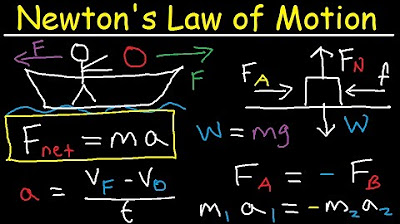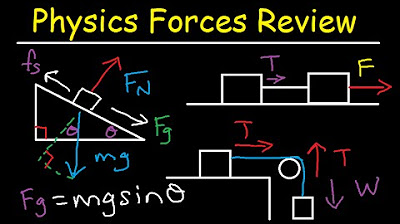Newton's 3 Laws of Motion for Kids: Three Physical Laws of Mechanics for Children - FreeSchool
TLDRThis video script explores Sir Isaac Newton's foundational laws of motion, which remain pivotal in classical mechanics. It explains the law of inertia, the relationship between force, mass, and acceleration, and the concept of action-reaction pairs. With examples like swinging, throwing a ball, and skateboarding, it illustrates how these principles govern everyday movements and the forces at play.
Takeaways
- 📚 Sir Isaac Newton's laws of motion, published in 1687, are foundational in understanding the motion of objects and are still in use today.
- 🏃 Newton's First Law, also known as the law of inertia, states that an object will remain at rest or in uniform motion in a straight line unless acted upon by an external force.
- 🤸♂️ The concept of inertia can be experienced practically, such as when starting and stopping a swing, which requires and resists force, respectively.
- 🌍 Earth's constant forces, like gravity and friction, influence the motion of objects, such as a thrown ball that rises and falls due to these forces.
- 🔢 Newton's Second Law quantifies the relationship between force, mass, and acceleration, expressed as Force = Mass × Acceleration.
- 🏋️♂️ The mass of an object determines the amount of force needed to change its state of motion or to accelerate it.
- 🚀 Newton's Third Law describes the reciprocal nature of forces, stating that every action has an equal and opposite reaction.
- 🌐 This law is exemplified by phenomena such as rocket launches, where the force exerted downwards results in an upward thrust.
- 🦅 The interaction between a bird's wings and the air demonstrates the Third Law, with the air pushing up against the wings in response to the downward force exerted by the wings.
- 🛹 Skateboarding illustrates Newton's Third Law as the skater pushes back against the ground, propelling themselves forward due to the ground's equal and opposite force.
- 🛴 The reduction of friction by skateboard wheels allows for the motion to continue for a period before other forces, like air resistance, slow the skater down.
Q & A
What did Sir Isaac Newton attempt to achieve with his observations on motion?
-Sir Isaac Newton aimed to describe the movements of the universe through mathematical observation, which he published in a book outlining his laws of motion.
What is Newton's First Law of Motion also known as?
-Newton's First Law of Motion is also known as the law of inertia.
What is inertia according to Newton's First Law?
-Inertia is the tendency of an object to keep doing what it's doing, which means an object in motion stays in motion and an object at rest stays at rest unless acted upon by an outside force.
Can you provide an example of Newton's First Law from everyday life?
-An example of Newton's First Law is using a swing on a playground, where you have to apply force to start swinging, and once in motion, it's hard to stop.
What force on Earth always acts on objects when they are thrown upward?
-The force of gravity always acts on objects when they are thrown upward, pulling them downward.
How is force related to mass and acceleration according to Newton's Second Law?
-According to Newton's Second Law, force is the product of mass and acceleration, meaning the greater the mass of an object, the more force is needed to change its velocity.
Why would it take more force to move a bowling ball than a beach ball of the same size?
-It would take more force to move a bowling ball because it has a greater mass than a beach ball of the same size, and force required to accelerate an object is directly proportional to its mass.
What does Newton's Third Law of Motion state?
-Newton's Third Law of Motion states that for every action, there is an equal and opposite reaction, meaning the forces two interacting objects exert on each other are equal in magnitude and opposite in direction.
How does the principle of Newton's Third Law allow rockets to launch?
-Rockets launch by exerting a force downward, and according to Newton's Third Law, an equal and opposite force pushes the rocket upward, allowing it to accelerate and move.
Can you explain how birds utilize Newton's Third Law of Motion when flying?
-When birds fly, their wings press down against the air, exerting a force. According to Newton's Third Law, the air pushes up against their wings with an equal force, allowing them to move upwards.
What role does friction play in stopping a moving object?
-Friction, which is the resistance caused by surfaces rubbing together, eventually brings a moving object to a stop by opposing its motion and dissipating its kinetic energy.
Why are Newton's laws of motion still considered important today?
-Newton's laws of motion are still important today because they provide the foundation of classical mechanics and help us understand the relationship between a body and the forces acting on it, which is crucial for predicting and analyzing motion.
Outlines
📚 Newton's Laws of Motion Overview
This paragraph introduces the fundamental concepts of motion as described by Sir Isaac Newton. It explains the three laws of motion, which are still pivotal in understanding the physical world. The First Law, or the law of inertia, states that an object will maintain its state of motion unless acted upon by an external force. The Second Law relates force, mass, and acceleration, indicating that the force needed to accelerate an object is directly proportional to its mass and the acceleration. The Third Law discusses action and reaction forces, asserting that every force has an equal and opposite reaction. The paragraph uses everyday examples like swinging, throwing a ball, and skateboarding to elucidate these principles, emphasizing their relevance and application in classical mechanics.
Mindmap
Keywords
💡Forces
💡Sir Isaac Newton
💡Laws of Motion
💡Inertia
💡Gravity
💡Friction
💡Mass
💡Acceleration
💡Action and Reaction
💡Classical Mechanics
💡Skateboarding
Highlights
Sir Isaac Newton's laws of motion help explain the relationship between a body and the forces acting on it.
Newton's First Law, also known as the law of inertia, states that an object will maintain its state of motion or rest unless acted upon by an outside force.
Inertia is the tendency of an object to resist changes in its state of motion.
The playground swing exemplifies Newton's First Law, requiring force to start but maintaining motion with less effort once in motion.
Gravity and friction are forces that act on objects thrown upward, eventually bringing them to a stop.
Newton's Second Law states that force is the product of mass and acceleration.
Mass is a measure of the amount of matter in an object, influencing how much force is needed to change its motion.
The greater the mass of an object, the more force is required to achieve the same acceleration.
Newton's Third Law asserts that for every action, there is an equal and opposite reaction.
The interaction between a ball hitting the ground and the floor exerting an upward force illustrates Newton's Third Law.
Rockets launch and jellyfish swim by utilizing the principle of equal and opposite forces.
Birds fly by pressing their wings against the air, which in turn pushes up against their wings.
Skateboarding demonstrates Newton's Third Law, with the skater pushing against the ground to move forward.
The wheels of a skateboard reduce friction, allowing the skater to glide forward before other forces slow them down.
Newton's laws, over 300 years old, remain fundamental to understanding motion and form the basis of classical mechanics.
The laws of motion are still relevant today for predicting and understanding the movement of objects.
Transcripts
Browse More Related Video

Newton's Law of Motion - First, Second & Third - Physics

GCSE Physics - Newtons First and Second Laws #56

Static & Kinetic Friction, Tension, Normal Force, Inclined Plane & Pulley System Problems - Physics

High School Physics - Newton's 3rd Law

Newton's Second Law of Motion | Newton's Laws of Motion | Video for Kids

Newton's second law of motion | Forces and Newton's laws of motion | Physics | Khan Academy
5.0 / 5 (0 votes)
Thanks for rating: